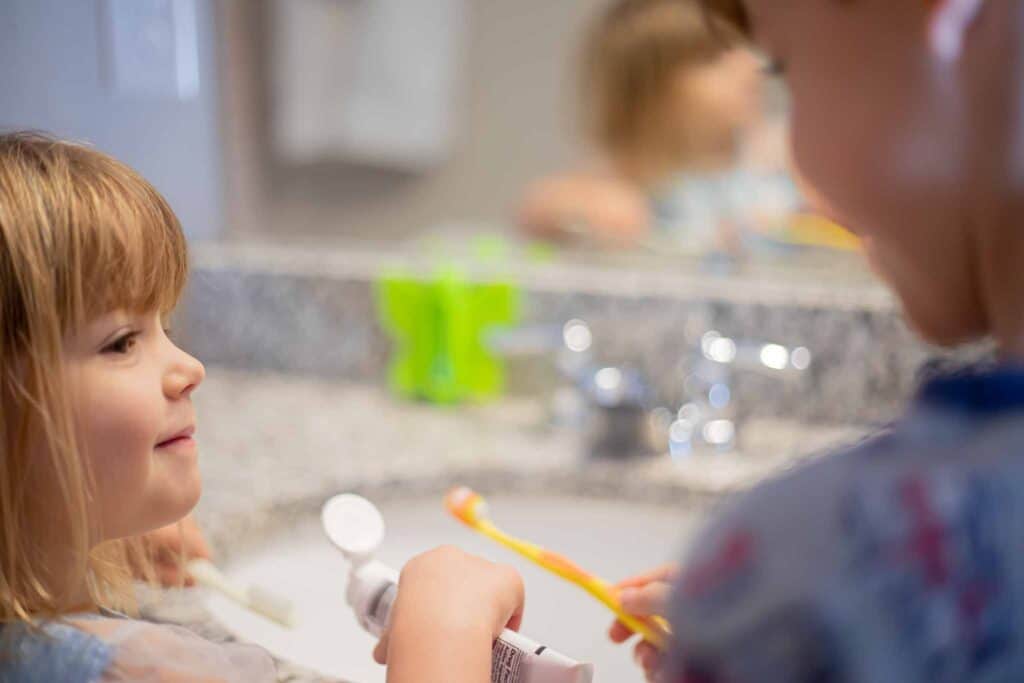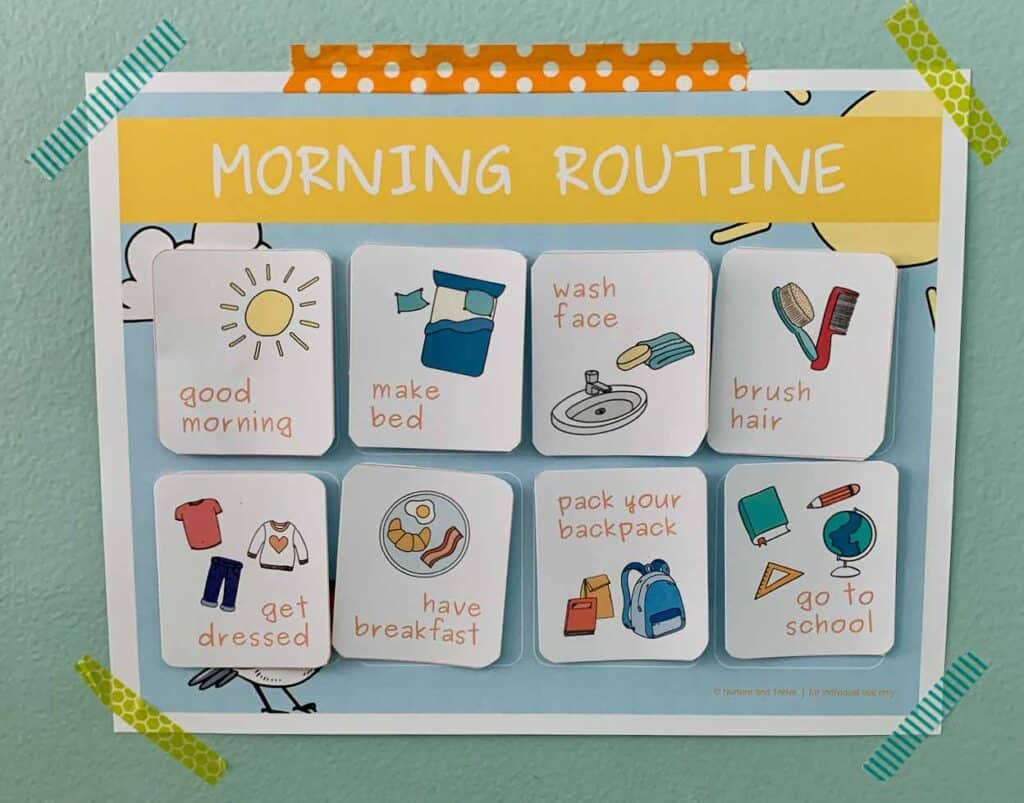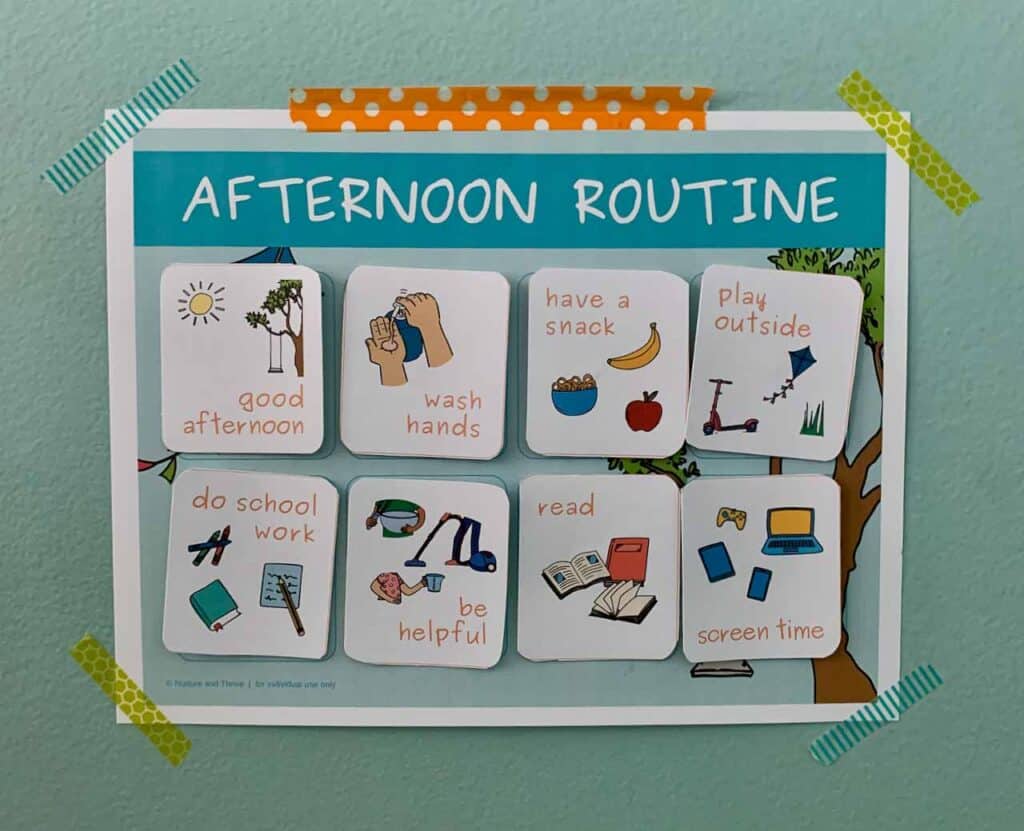Inside: Routines for kids and families are a foundation for peaceful days. Routines bring a sense of predictability and consistency into young children’s days, leading to feelings of safety and security. Rather than being rigid, flexible routines help children adapt to change and transitions.
Does your child resist leaving the house when it’s time? What about brushing their teeth before bed? Is your child having tantrums about screen time limits? Maybe it’s time to adopt a family daily routine.
Children thrive on routines for three reasons: a routine can make them feel safe and secure, and help them regulate their behaviors and emotions.
For toddlers and children, time is an abstract concept. As adults, we conceptualize time in a 24-hour day, a 7-day week, and a 12-month year.
When we tell our child, “it’s time to go,” it can feel like we arbitrarily decide it is time to go. If you think about it, yes, our concepts of time are arbitrary. And like how babies understand the rules of physics on some deep level, kids get that time is an abstract concept, and yet, at the same time, they don’t quite have the brain maturation to fully conceptualize it.
Young children are also developing a strong and healthy sense of self and the desire for independence and autonomy over their lives. Hence, when you say, “it’s time to go,” it can become a power struggle.
What is the answer? A consistent yet flexible daily routine.

Why Daily Routines Are Good for Children: Safety, Regulation, and Secure Connection
A consistent routine creates predictability in your toddler’s or child’s day. They may not have fully internalized a 24-hour day and 7-day week, but when meals, snacks, naps, and bedtime happen around the same time, they have predictable anchor points to their days.
That predictability makes children feel safe and secure.
Moreover, a predictable and consistent routine helps create a system of regulation around your child. Because children are still developing self-regulation (maturity of regulation systems in the brain starts at age 7, but development continues long after that), external regulation in the form of a routine supports their ongoing development.
And finally, a predictable and consistent routine increases family bonding and connection. Routines and rhythms naturally create family rituals and traditions — things like Friday pizza and movie night become special to your family.
These simple traditions create a sense of belonging, connection, and security. It can help to create your family culture.
Benefits of Daily Routines for Kids: Fewer Power Struggles!
Transitions are hard for children. Turning off screens, going outside to play, leaving the house to run errands, coming home from the park — all of these things involve transitioning.
Fewer Power Struggles
When your child knows that it is “outside time” because it is part of the daily routine, they won’t expect to watch TV at that time.
They know, that tomorrow, they will have screen time or park time again — and they know what is coming next — snack and story. With time and consistency in their daily routines, children begin to show less resistance to transitions between activities because they have predictability as well as a feeling of some control over their days.
Less Parental Mental Load
Creating a daily routine that works for your family takes some work at first, but it pays off. You won’t have to spend as much time preparing your child for transitions.
Also, your own mental load is reduced. You don’t need to decide what comes next — what needs to be done in a day — or when to do what. You don’t need to recreate the wheel every single day.
Instead, you include habits and activities in your daily routine that work for you and for your family. Perhaps you even include a moment of quiet as part of the routine for yourself!
How to Start a Daily Routine for Kids
First, start by brainstorming a list of all of the things that happen for each member of your family on a daily basis. Start with yourself first — what do you need to do on a daily basis? And this list shouldn’t just include all of your “should dos,” be sure to include things you like to do. And also healthy habits like 15 minutes of sunshine, exercise, and quiet time for yourself.
Here’s what your day may look like incorporating routines for your kids, notice how having the routines could reduce your mental load of keeping track of everything that needs to get done.
Sample Daily Routine for Kids and Families
- Wake up, shower, and get ready
- Spend 15 minutes meditating or quietly with yourself before the kids get up
- Breakfast and the kids do their morning routines
- Leaving for school, work, preschool, or errands
- Lunch
- Outside time with preschoolers or toddlers
- Naptime for younger kids (work, exercise, rest, or meal prep for you)
- Kids do their afternoon routines, including household time and homework time (everyone pitches in for laundry, clean up, or other)
- Dinner
- Family Time and Activities
- Kids do their bedtime routines
Depending on the age of your children and whether you work outside of the home, this routine can look quite different from person to person. The idea is that they are anchor points to the day — and that what is important to you is included.
Once you craft your routine, brainstorm a daily schedule for each family member. Make a list like the one above and look for the commonalities between them. The key is that you want a flexible routine that works and not a rigid routine.
You will need to make adjustments as kids grow and as your family life changes. And it is always a good idea to shake things up every once in a while. The first thing I suggest when parents say their child is resisting bedtime is to throw out their current routine.
For some families, a more detailed routine is better; for others, a looser daily rhythm is better. Just make sure your child has those daily anchor points and a few family touchpoints.
Ideas for Family Time: Rituals and Traditions
When you don’t have tons of activities, like soccer, music lessons, and so forth in the evenings, it can be fun to create a rotating schedule of fun family traditions.
- Monday – Reading and Tea: After dinner, we all read our own books, or sometimes we read aloud. Recently we’ve been reading Harry Potter. This is my favorite because it is quiet!
- Tuesday – Game Night: This might just be a quick game after dinner or school because we often have other activities on Tuesday.
- Wednesday – TV: We watch a show the whole family likes!
- Thursday – Go Outside: We might walk longer, throw some logs on the firepit, or look at the stars before bed.
- Friday – Movie Night: We all look forward to movie Fridays!
You won’t do all these activities every week, but they are there when you have the time. And also, notice some of these things could just be 15 minutes.
Think of these family activities as little touchpoints of comfort and connection throughout your week. A quick game of Uno at the dinner table or looking at the stars can bring you into the present and spend time with the ones you love.
What to Do When A Routine is Impossible
Sometimes when you are traveling or during the holidays, you won’t be able to stick to your routine. This is when having those touchpoints in your routine is extremely helpful.
Let’s say it is the holidays, and you are visiting family. Dinner time is set by your hosts, and the gift opening is happening right before naps. What can you do?
Incorporate aspects of your child’s routine when you can. Give them a snack when they are used to getting snacks, have a quiet time instead of a nap if a nap isn’t possible, and get outside if they are used to that as well.
Those anchor points will not only stave off over-hungry and over-tired children but will also give your kids a sense of security and comfort during a potentially over-stimulating time.
Example Routines for Toddlers, Preschoolers, and School-aged Children
Example Toddler Daily Routine
Toddlers thrive on predictability with some flexibility in their daily routines. Be sure to include all of the tasks that your toddler may sometimes resist: toothbrushing, bath time, bedtime, etc.
Include your toddler in creating the routine. Ask them how they get ready in the morning and create a chart like this one together. Then, go through what to do before bed and create another chart.

Including aspects like leaving the house for errands and outside time is helpful for transitions. Toddlers also respond well to playful transitions and songs about transitions.
7:00 am Wake-Up and Morning Routine
7:30 Breakfast and Help Clean-Up
8:45 Snack
9:00 Outside Time/ Play Time/ Meet-up with Playgroup
11:30 Lunch
12:30 Read in Room
1:00 Nap
3:00 Snack
3:30 Play/ Errands /Park
5:30 Watch a TV show
6:00 Dinner
7:00 Bedtime Routine and go to sleep
Example Preschooler Daily Routine
Preschoolers also thrive on having a predictable routine. It is a good idea for preschoolers to incorporate some time for household chores, outside time, and quiet time if they have dropped their naps.
Include your preschooler when you create their routine. These routine charts are great because you can start with a pile of activities and tasks, and your preschooler can help stick them on the chart. For toddlers, you may have a simpler chart with morning, afternoon, and bedtime. For preschoolers, you may have three separate ones with more activities.
7:00 am Wake-Up and Morning Routine
7:30 Breakfast and Help Clean-Up
8:30 Preschool
12:30 Lunch
1:00 Storytime
1:15 Nap or Quiet time in their room
2:00 Snack and Household Chores
3:30 Play/ Errands /Park/ Open-Ended Play with Materials
5:00 Watch a TV show or Other Screens
6:00 Dinner
7:00 Family Night Fun
8:00 Bedtime Routine and go to sleep
Example School-Aged Children Daily Routine
Having a daily routine for school-aged children gives them a sense of responsibility. It also teaches them time management.
As your child gets older and has more activities, it is even more important to have special time and activities the entire family can enjoy together.

Research shows it is also good to come together for mealtimes when you can. Sometimes, that might be a pancake breakfast together on Saturday morning.
7:00 am Wake-Up and morning routine (now including backpacks and lunches)
7:30 Breakfast and Help Clean-Up
8:00 School
3:30 Snack
4: 00 Play Outside/ Park/ Activities
5:00 Homework/ Household Chores
5:30 Watch a TV show or Other Screens
6:30 Dinner
7:30 Family Night Fun
8:30 Bedtime Routine and go to sleep
Keep in mind these are just examples of what a daily routine could look like. It will be different for each family. Some may be more detailed, and some may be less detailed. Remember to be flexible. As long as you have anchor points and family touch points, you will feel the benefits of a daily routine even during the times a routine is hard to maintain!

 10 Ways to Stop Yelling At Your Kids and Instead Coach Them Through Emotions
10 Ways to Stop Yelling At Your Kids and Instead Coach Them Through Emotions